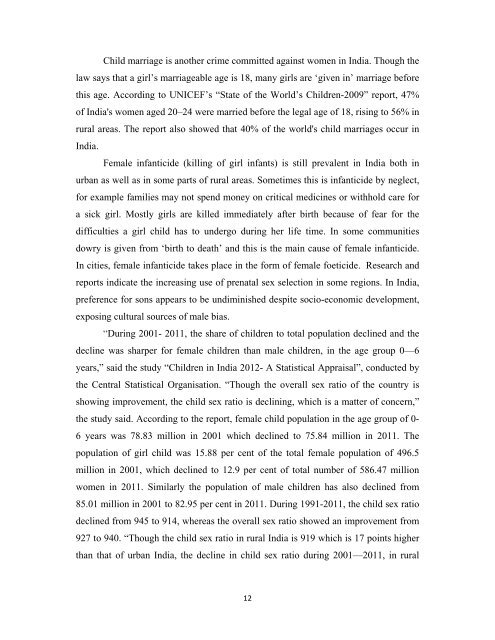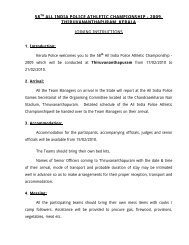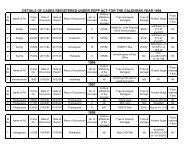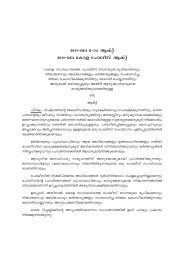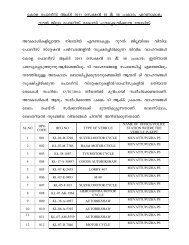Study Report - Women Victims of Crimes in Kerala - Kerala Police
Study Report - Women Victims of Crimes in Kerala - Kerala Police
Study Report - Women Victims of Crimes in Kerala - Kerala Police
You also want an ePaper? Increase the reach of your titles
YUMPU automatically turns print PDFs into web optimized ePapers that Google loves.
Child marriage is another crime committed aga<strong>in</strong>st women <strong>in</strong> India. Though the<br />
law says that a girl’s marriageable age is 18, many girls are ‘given <strong>in</strong>’ marriage before<br />
this age. Accord<strong>in</strong>g to UNICEF’s “State <strong>of</strong> the World’s Children-2009” report, 47%<br />
<strong>of</strong> India's women aged 20–24 were married before the legal age <strong>of</strong> 18, ris<strong>in</strong>g to 56% <strong>in</strong><br />
rural areas. The report also showed that 40% <strong>of</strong> the world's child marriages occur <strong>in</strong><br />
India.<br />
Female <strong>in</strong>fanticide (kill<strong>in</strong>g <strong>of</strong> girl <strong>in</strong>fants) is still prevalent <strong>in</strong> India both <strong>in</strong><br />
urban as well as <strong>in</strong> some parts <strong>of</strong> rural areas. Sometimes this is <strong>in</strong>fanticide by neglect,<br />
for example families may not spend money on critical medic<strong>in</strong>es or withhold care for<br />
a sick girl. Mostly girls are killed immediately after birth because <strong>of</strong> fear for the<br />
difficulties a girl child has to undergo dur<strong>in</strong>g her life time. In some communities<br />
dowry is given from ‘birth to death’ and this is the ma<strong>in</strong> cause <strong>of</strong> female <strong>in</strong>fanticide.<br />
In cities, female <strong>in</strong>fanticide takes place <strong>in</strong> the form <strong>of</strong> female foeticide. Research and<br />
reports <strong>in</strong>dicate the <strong>in</strong>creas<strong>in</strong>g use <strong>of</strong> prenatal sex selection <strong>in</strong> some regions. In India,<br />
preference for sons appears to be undim<strong>in</strong>ished despite socio-economic development,<br />
expos<strong>in</strong>g cultural sources <strong>of</strong> male bias.<br />
“Dur<strong>in</strong>g 2001- 2011, the share <strong>of</strong> children to total population decl<strong>in</strong>ed and the<br />
decl<strong>in</strong>e was sharper for female children than male children, <strong>in</strong> the age group 0—6<br />
years,” said the study “Children <strong>in</strong> India 2012- A Statistical Appraisal”, conducted by<br />
the Central Statistical Organisation. “Though the overall sex ratio <strong>of</strong> the country is<br />
show<strong>in</strong>g improvement, the child sex ratio is decl<strong>in</strong><strong>in</strong>g, which is a matter <strong>of</strong> concern,”<br />
the study said. Accord<strong>in</strong>g to the report, female child population <strong>in</strong> the age group <strong>of</strong> 0-<br />
6 years was 78.83 million <strong>in</strong> 2001 which decl<strong>in</strong>ed to 75.84 million <strong>in</strong> 2011. The<br />
population <strong>of</strong> girl child was 15.88 per cent <strong>of</strong> the total female population <strong>of</strong> 496.5<br />
million <strong>in</strong> 2001, which decl<strong>in</strong>ed to 12.9 per cent <strong>of</strong> total number <strong>of</strong> 586.47 million<br />
women <strong>in</strong> 2011. Similarly the population <strong>of</strong> male children has also decl<strong>in</strong>ed from<br />
85.01 million <strong>in</strong> 2001 to 82.95 per cent <strong>in</strong> 2011. Dur<strong>in</strong>g 1991-2011, the child sex ratio<br />
decl<strong>in</strong>ed from 945 to 914, whereas the overall sex ratio showed an improvement from<br />
927 to 940. “Though the child sex ratio <strong>in</strong> rural India is 919 which is 17 po<strong>in</strong>ts higher<br />
than that <strong>of</strong> urban India, the decl<strong>in</strong>e <strong>in</strong> child sex ratio dur<strong>in</strong>g 2001—2011, <strong>in</strong> rural<br />
12


